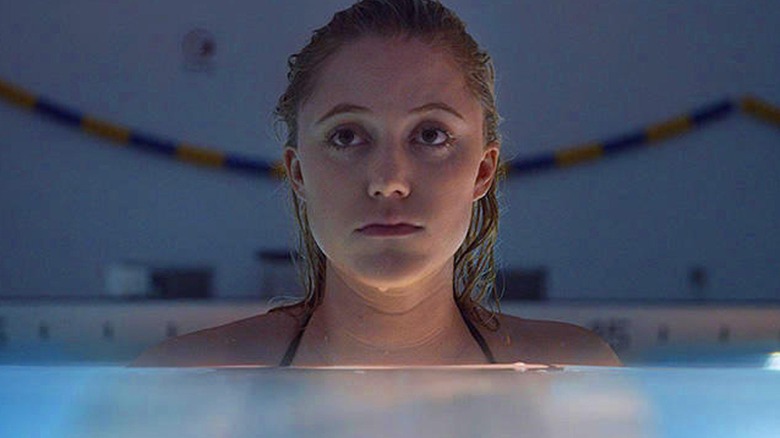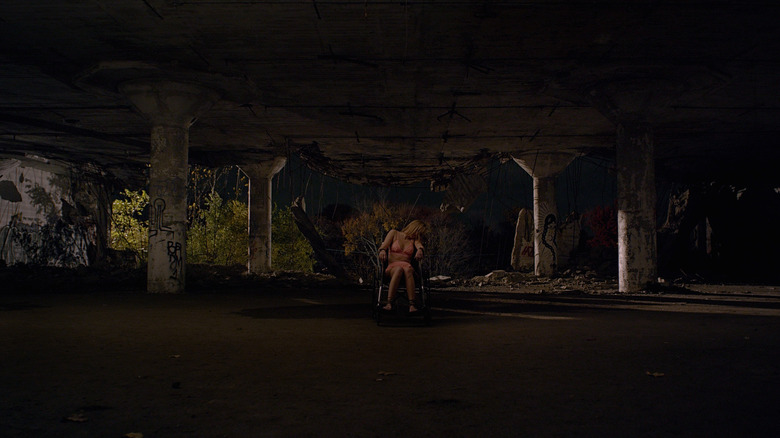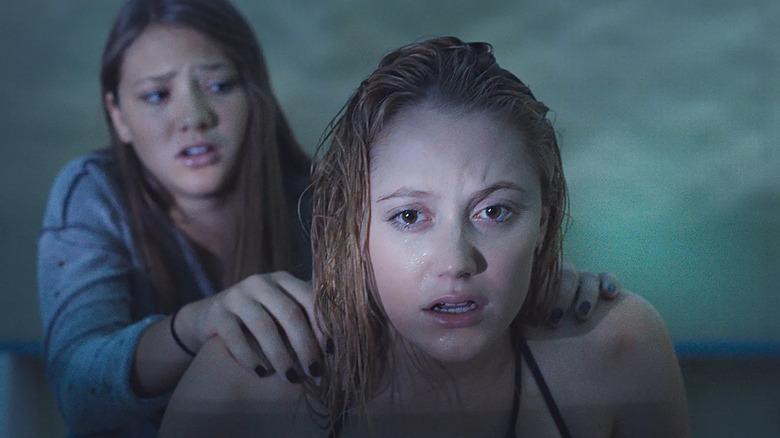How It Follows' Ending Ruined A Great Horror Movie
When David Robert Mitchell's film "It Follows" was released in 2015, it officially codified the growing trends in the horror of the decade. Low-fi and high-concept, "It Follows" was a quiet film, set in mundane locations and about ordinary people, able to wring dread out of seemingly innocuous scenarios. "It Follows" would be released around the likes of "Hereditary," "The Witch," and "It Comes at Night," all slow-burn, contemplative horror movies that slide their fingernails under your skin and do not let go.
The monster of "It Follows" was ... people. An ineffable, formless ghostly being, able to look like any random stranger, would slowly walk toward its intended victim. The ghost, acquired from a sexual encounter, would follow you. It would merely walk. And walk. And walk. And walk. You could run, but it would never stop walking. If the ghost caught up, well, something truly horrible would happen to you. The ever-expanding dread, dreamlike tone, and unique concept behind "It Follows'" led many to declare it one of the scariest films in years.
Indeed, "It Follows" may hold a viewer so powerfully under its spell that one may not notice that the film's finale — involving a swimming pool and carefully hurled toasters — leaves a lot to be desired. After dealing with a creature that draws all its horrific power from remaining abstract, the climax reduces the monster to something no different from a Wolf Man or a Dracula, complete with a set of mechanical rules and repeatable actions that make it seem entirely unthreatening.
The premise
"It Follows" does explain its own mythology early on. Following a casual hookup, the film's heroine, Jay (Maika Monroe), is informed by her partner that he passed a malevolent spirit on to her. He proves it to her by tying her to a chair and forcing her to watch the ghost slowly encroaching. Later in the film, Jay will also learn that she can rid herself of the ghost by sleeping with someone else, passing the infection to them. However, if the ghost were to kill her next partner, it would revert back to stalking her. The ghost in "It Follows" can easily be seen as a metaphor for an STI, but one might also be able to read it as a form of cultural guilt associated with sex. Either way, Jay has a ghost on her trail.
The ghost follows Jay into her home; it follows her at school; it follows her to a gathering down on the beach. In some cases it's easy to spot — a nude man standing on the roof of a suburban home is a dead giveaway — while at other times, it seems chillingly undetectable, indistinguishable from the crowd around it. In one instance, the ghost looks like a friend; in another, it resembles Jay's dead father. At one point, Jay attempts to pass the creature onto others, but it comes back around to her pretty quickly. None of Jay's flesh-and-blood friends can see the ghost, but they are at least game to help, and they believe her when she says she's in danger.
Their willingness to help leads to the aforementioned disappointing climax wherein a group of plucky teens, armed with guns and television sets, try to physically harm the ghost. Yes, they try to shoot a ghost in the head.
The climax
Perhaps uncreatively, the ghost in "It Follows" can be hurt in the usual way one might get hurt. Thwacking it with a stick or shooting it with a bullet seems to temporarily slow it down. Rather than use their wits to solve the problem or enact a clever ploy to undo the curse, the characters in "It Follows" seek to overwhelm the Follower by brute force. Jay waits out in the center of a swimming pool and waits for It to follow her there. Their plan: When the creature climbs into the water to attack Jay, Jay will leap out in time for her friends to throw electrical devices into the water, electrocuting it. The creature smartly avoids the pool, but we learn quickly that it has a weakness to bullets. A bullet into its head ultimately kills it. The ghost's body is invisible, but its blood can be seen.
When the unstoppable becomes stoppable, it becomes way less scary. Freddy Krueger, for instance, is scary because he can operate by the logic found within a dream. He can magically alter the world to his whim. If one knows they can best Freddy in a fistfight, that makes his supernatural powers seem extremely limited. The same can be said of the ghost in "It Follows." Once it has specific rules that allow for its defeat, well, then a plan can be formulated to take care of it next time.
An "It Follows" ghost, then, is no more inconvenient than changing the oil in your car. You may not like changing the oil in your car, but it's not the kind of activity that strikes dread deep into your bones. The climax of "It Follows" could certainly have used more wit.


